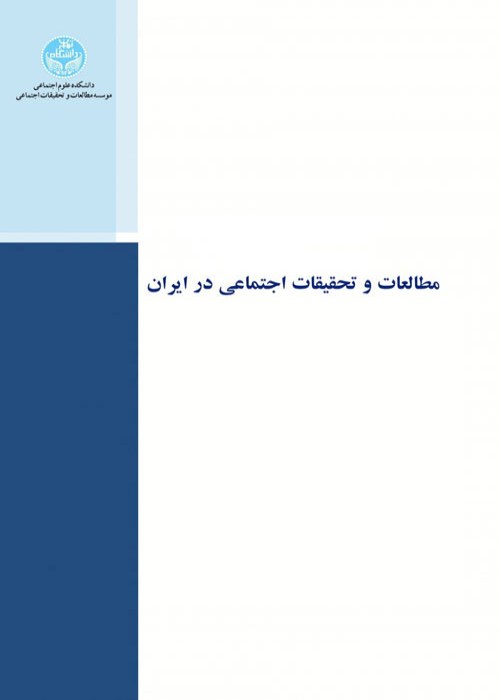Evaluating Effectiveness of Street Children Managing Plan of Iran
Author(s):
Article Type:
Research/Original Article (دارای رتبه معتبر)
Abstract:
Introduction
State Welfare Organization has been appointed as responsible for managing street children since 2005 and delivering services to these children and their families through national Street Children Managing Plan. The Plan has four service delivery levels and the aim of this study is to evaluate the effectiveness of short term residential centers (second level centers) in achieving its goals. These centers have the facilities to reside street children up to 21 days and to deliver medical, nutrition, financial, social work, psychological, legal and job training services to street children and their families. Method
This research is a descriptive-analytical survey. The statistical population of the study is all street children registered in short term residential centers and their parents/caretakers in four provinces selected by State Welfare Organization (Tehran, Kordestan, Semnan, and Sistan & Baluchestan). Data were collected by two researcher-made questionnaires for children and families. The total sample size was 279 but finally 124 cases of the children and 98 cases of caregivers filled questionnaires and the data were analyzed by SPSS software. According to the main objectives of evaluation, the self-report questionnaire of children consisted of six parts: education, child safety and abuse; working situation; caregiving and guardianship; quality of life; and professional empowerment. The self-report questionnaire of families also consisted of job services, financial empowerment and social rehabilitation. Face validity of both the questionnaires were confirmed by 10 experts in social science and social work fields. Results and discussion
According to the findings, 96.42% of participated children were boys and 83.87 of them were Iranian. There wasn’t any meaningful difference in the status of children education after the program implementation. The status of children working hours was changed meaningfully as 23% of them didn’t work anymore. Given the status of caregiving and guardianship, about 15% of the children were not under the guardianship of their incompetent parents anymore and instead grandparents and relatives have more share of the caregiving. There was a meaningful difference in the status of basic needs of children (physical, health, shelter, love and nurturing) but the difference wasn’t meaningful in need of leisure. According to the goal of improving the family capacities, only 20% of the families were empowered due to the scales. Conclusion
Overall, the Plan had a significant effect on working status and hours, guardianship, meeting basic needs and improving the quality of life of working children, but did not have a significant outcome on their education and secondary needs. Also children and their families believed that the services aiming empowerment weren’t enough and effective and only the financial supports could increase the working status and hours of the children and improve their education in some cases. Regarding the objective of improving education status of street children, it could be discussed that empowerment services and social rehabilitation of the families weren’t comprehensive and evidence-based and were limited to financial support. Also statelessness and having no identity cards weren’t addressed in the plan as the main obstacle of formal education. Improving the family capacities was among the main objectives of the plan, but the result of gaining this goal was not promising. According to the findings of this study, it can be stated that the national Street Children Managing Plan was not successful in achieving its goals, and the empowerment of children and families did not reached to an anticipated level. So, it is necessary for State Welfare Organization to expand evaluating programs to other aspect of the plan and also other collaborating organizations and NGOs should be involved to realize the comprehensive and universal picture of implementing national Street Children Managing Plan.Keywords:
Language:
Persian
Published:
Quarterly of Social Studies and Research in Iran, Volume:9 Issue: 4, 2020
Pages:
827 to 854
magiran.com/p2209768
دانلود و مطالعه متن این مقاله با یکی از روشهای زیر امکان پذیر است:
اشتراک شخصی
با عضویت و پرداخت آنلاین حق اشتراک یکساله به مبلغ 1,390,000ريال میتوانید 70 عنوان مطلب دانلود کنید!
اشتراک سازمانی
به کتابخانه دانشگاه یا محل کار خود پیشنهاد کنید تا اشتراک سازمانی این پایگاه را برای دسترسی نامحدود همه کاربران به متن مطالب تهیه نمایند!
توجه!
- حق عضویت دریافتی صرف حمایت از نشریات عضو و نگهداری، تکمیل و توسعه مگیران میشود.
- پرداخت حق اشتراک و دانلود مقالات اجازه بازنشر آن در سایر رسانههای چاپی و دیجیتال را به کاربر نمیدهد.
In order to view content subscription is required
Personal subscription
Subscribe magiran.com for 70 € euros via PayPal and download 70 articles during a year.
Organization subscription
Please contact us to subscribe your university or library for unlimited access!


